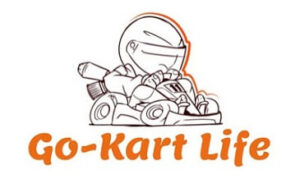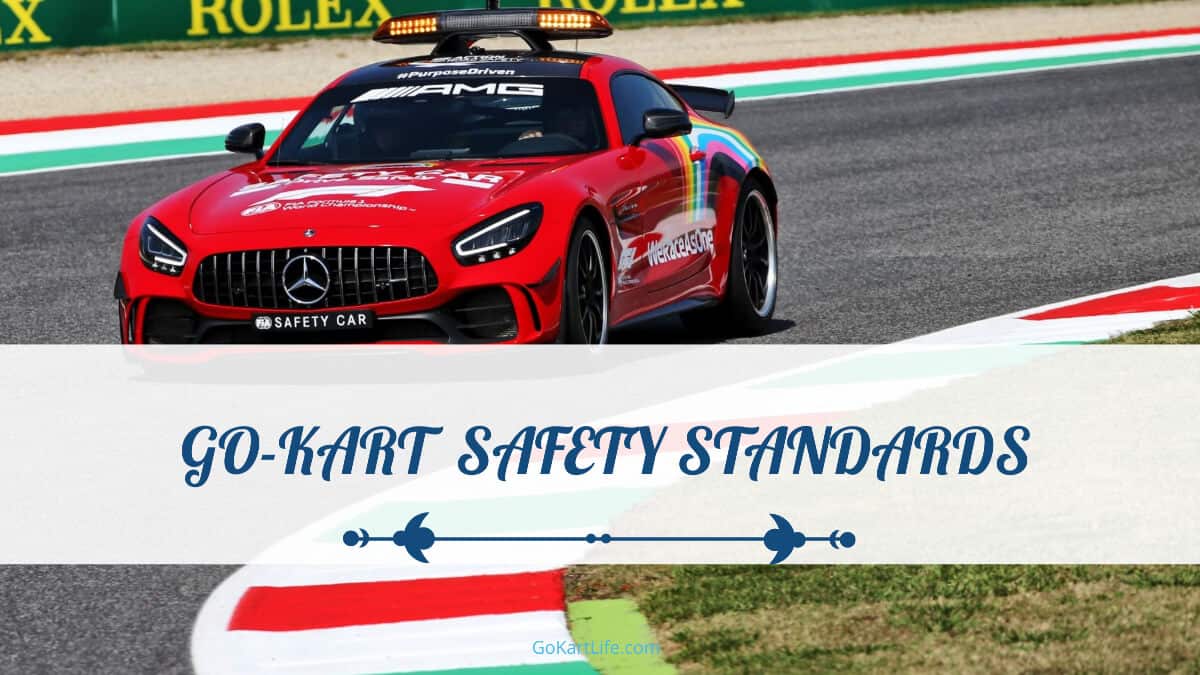Go-karting is a motorsport that offers thrill, excitement, and entertainment to both drivers and spectators of all ages. However, because go-karting requires drivers to travel at speeds from 12 miles per hour to almost 100 in competitive racing—and sometimes while navigating tight curves on the racetrack—safety is a top priority to protect the drivers and anyone working on or near the track.
Go-Kart Safety Standards
The following is a list of key go-kart safety standards. These standards have been developed over time to ensure everyone who participates in the activity—from kids to professional racers—is protected from potential injury—and even fatalities in severe cases.
Protective Go-Karting Gear Requirements
First and foremost, all racers are required to wear protective gear, head to toe, to protect them in the event of an accident. This includes helmets, go-kart-friendly clothing, gloves, and closed-toed shoes.
Helmets
A go-kart helmet is one of the most critical pieces of safety equipment you’ll need when go-karting. Most go-kart tracks require drivers to wear SNELL approved helmets, which have passed a series of safety regulations.
The helmet you use should have a strong face shield and be made up of a sturdy, lightweight material covering the entire head. This will protect your head from trauma or injury in the event you have a collision.
If drivers have long hair that extends below the helmet while worn, they must tie the hair up; this will ensure their hair does not get tangled with any go-kart components, like the seatbelt, or is pulled should an accident occur.
Clothing
Go-kart drivers should not wear loose clothing or jewelry when entering the race track. Similarly to the reason drivers should tie up their hair, this ensures clothing does not catch and get stuck in any go-kart components.
To prevent or minimize abrasion to the body in an accident, heavyweight jackets, such as leather, vinyl, or some other abrasion-resistant material, along with full-length pants made of the same material, are required to be worn by the driver.
Gloves and Shoes
Open-toed shoes are not permissible on go-kart race tracks. Instead, drivers should wear comfortable shoes or boots that fully cover their feet. Go-kart racing gloves are also mandatory and need to be worn at all times while operating a go-kart.
Safe Go-Kart Track Design and Layout Standards
All go-kart tracks must follow the standard specifications that protect and safeguard the drivers, pit stop operators, and spectators.
Surface Material
The track is required to be made of a non-skidding material such as concrete or asphalt. The tracks need to be smooth and durable, and the length should not exceed more than a quarter of a mile. Materials such as crushed rock or gravel are prohibited from use on the track.
Layout
There are several requirements the go-kart track itself must meet to conform to safety standards:
- General Track Layout: The tracks should be oval or based on road course configurations. At any given point, the length of straight portions on the raceway should not exceed 300 feet. The track’s required width is at least 16 feet for straight paths and at least 20 feet at the turns. The courses are only allowed to be elevated (banked) on turns.
- Track Indicators: Unique markings must indicate the entry and exits to the track. The track’s edges should be marked with a wide white line easily noticeable to the driver.
- Track Barriers: All course curves should have a safety barrier that consists of rubber tires, bales of hay, plastic barrels, or any other material. For tracks with two sections close to each other, safety barriers should be appropriately installed to eliminate the possibility of karts crossing over the area.
- Designated Maintenance Zone: All tracks are required to include a “no man’s land.” If a mechanical lane is provided, it should be beside the main track and marked. Moreover, the course should include designated areas to park service vehicles and store track maintenance equipment.
- Catch Traps: Go-kart tracks should also include catch traps to protect the kart and the driver if the kart goes off the track. A catch trap is an area of loose material, such as woodchips or gravel, placed in front of the safety barrier, intended to slow down a rouge kart.
- Safety Catch Fence: In addition to catching traps, the course should also be equipped with a safety catch fence that acts as a line of restraint in areas where the kart is most likely to run off-track.
Lighting
The tracks should be well lit so that no shadows are cast on the course at any point; this will enable drivers to see potential turns or obstacles in their path clearly.
Additionally, the lights on the racetrack should not cause glare for drivers or track operating personnel. All tracks should also have an emergency lighting system if the main power is lost for any reason.
Pit Stops and Paddock
The pit stops should be clearly labeled and have different entrance and exit lanes to avoid potential collisions. These areas and paddocks should be gated and remain closed if they are not in use.
Pit stop operators are required to stay within the pit area while the track is being used. Spectators should be prohibited from entering pit stops.
Fencing Requirements
All go-karting tracks should be within a fenced enclosure. These fences should be at least 48 inches high and a minimum of 36 inches from the track’s barrier. The spectators should be separated from the course and pit stop areas, with the stands constructed outside of the fencing. This will protect the spectators should an incident occur on the tracks.
Track Maintenance
To further ensure drivers are safe during races, track owners must regularly inspect the course for loose materials, bumps, and potholes and provide repairs as needed.
Related Article: Discover The 10 Best Off-Road Go-Karts For The Ultimate Adventure!
Safe Go-Kart Design Standards
Like with the go-kart track’s design and layout, the actual karts used in races must be designed and manufactured with safety in mind.
Material and Design
The go-kart should be built with a lightweight material that provides structure and is strong enough to withstand any impact.
- Go-Kart Frame: Go-karts are usually made with sturdy material such as steel or aluminum and should include bumpers (made from non-metallic material) for shock absorption.
- Go-Kart Harness: Additionally, all go-karts should have the proper safety harness. All go-karts must have a multi-point harness system that prevents the driver from being thrown from the kart in case of a collision.
- For example, the five-point harness system is worn across the driver’s shoulders and hips. If an accident occurs, the crash’s force will transfer to the body’s rigid points (shoulders and hips) and the seat. Therefore, the soft body parts—like the abdomen—remain safe from impact.
- Go-Kart Seating Area: Go-karts should only have room for one person to occupy unless they are intentionally designed to accommodate two or more individuals. The leg area and backrest on the seat need to be made to help secure the driver in place if a collision occurs or the kart rolls over.
- Go-Kart Fuel Tanks: The fuel tanks should be designed to ensure that they do not rupture even in a crash.
Additionally, all go-karts used at go-karting facilities must have an identification number that the operator can easily recognize.
Speed
Generally, a go-kart’s max speeds should be appropriate for the type of track it is designed for. However, in some cases, karts will be designed to allow users to adjust the kart’s max speed for various courses; in these instances, such controls should only be accessible to operating personnel and should not be left to the driver to control under any circumstance.
Brakes and Control Buttons
The go-kart’s brakes and control mechanisms should be in areas easily accessible to the driver. The braking system should be capable of bringing the kart—when at max speed—to a complete stop within 40 feet.
If your kart cannot come to a complete stop within 40 feet, consider replacing go-kart brake pads.
Maintenance and Inspection
Go-karts should be inspected daily and before the operation to ensure that the steering mechanism, wheels, axles, safety belts, seats, brakes, throttle, gas tanks, and tires are fully operational.
If the go-kart does not meet any of the required safety standards, it should be deemed non-operational until the maintenance has been completed, and the issue has been fixed.
Safe Go-Kart Driving Standards
Drivers should always follow the go-karting facility’s safety instructions and complete safety training for operating the go-kart before hitting the track.
Safe Go-Kart Driving Rules
All drivers sharing the track have a duty of following the below practices to ensure the safety of themselves and fellow drivers; they are expected to abide by these driving rules while on the course:
- No Bumping Allowed: Drivers should refrain from blocking other drivers on the course or bumping into other karts. The drivers should drive within their means and not try to pass other karts if they know that it may result in contact or a potential collision.
- Always Remain in the Kart: If any unfavorable situation arises on the track, drivers should refrain from getting out of the kart or pushing the kart away from any barriers. Instead, drivers should always stay in their kart and wait for track operational personnel to assist them.
- Drive Slowly at Entrance and Exit Points: Drivers are always recommended to drive slowly and watch for any passing karts when entering or exiting the track. Those already on the track are likely traveling at full speed and will be unable to break in time should you suddenly enter or slow down to exit the course. This can lead to a loss of control of their kart and a potential crash if their kart fails to break immediately.
- Drive Carefully Near Pit Stops: On a given track, all go-karts must start and stop at the same time if they are operating from the same pit stop to avoid a collision.
- Respect the Flags: Drivers should always be alert while go-karting and honor the flags and waved by operating personnel. Each facility usually has different go-kart flags to indicate several signs and warnings:
- Green Flag: A green flag indicates that you should start the race.
- Red Flag: A red flag indicates that you should stop the race.
- Blue Flag: A blue flag indicates that you should let other drivers pass.
- Yellow Flag: A yellow flag indicates that you should slow down.
- Black Flag: Some tracks may include a black flag to indicate that you need to return to the pit and speak with a track operating personnel.
- Checkered Flag: A checkered flag indicates the end of the race.
Health Requirements
Go-karting may aggravate certain physical conditions; it is not recommended that you go go-karting if the following applies to you:
- You are pregnant.
- You are suffering from a heart condition.
- You experience epilepsy.
- You have neck or back injuries.
- Have symptoms of whiplash.
- You are required to wear a cast.
In other words, you should only drive a go-kart if you are in good health, do not have any history of medical conditions, and feel comfortable and confident enough to drive.
Age and Height Requirements
Go-karts come in various sizes, and they need to be assigned to drivers strictly based on their age and height.
Adult go-karts are usually not granted for use for individuals with a height of less than 56 to 60 inches and/or under nine years of age. Some tracks allow children as young as 12 to use adult karts. Go-karting tracks specially designed for children may require a minimum height of 48 inches.
Note: Parents and guardians need to abide by the track facility’s rules to protect children and avoid crashes due to their failure to operate the kart safely.
Prohibited Substances
Driving under the influence of drugs or alcohol can impair your ability to drive safely. Therefore, all drivers are required and expected to be sober when operating the kart.
If drivers are taking any medications that may cause side effects such as drowsiness or nausea, they should not be allowed to drive or operate a go-kart.
Essential Go-Karting Safety Equipment
Dangerous situations may arise at any time while go-karting. Therefore, all go-kart arenas must be well-equipped with the following safety equipment.
Fire Extinguisher
The danger of fire is always present in go-karting, considering the kart has a fuel tank driven with and around high-powered electrical systems. Therefore, every track must be equipped with a fire extinguisher in the pit, kart storage, maintenance shop, and refueling areas.
These fire extinguishers should contain a material safe for flammable liquid and should be non-hazardous.
It is also recommended to install a fire extinguisher inside the kart so that the driver can protect themselves from flames if they get trapped in the car after a crash. These fire extinguishers should always be readily accessible.
First-Aid Kit
Go-kart facilities should have a first aid kit on site that is readily available at all entrances and in-pit areas to care for any minor injuries.
A medical professional, such as a physician or a paramedic, must be present throughout the event during professional races.
Some states require that in addition to a medical kit, the go-karting arena should have a medical room to treat injured individuals.
Emergency Communication
All tracks are required to have an active emergency communication system. Mobile phones can be used for communication, but they may sometimes face reception issues. This makes it essential to have a radio backup that can always contact emergency personnel.
Importance of Go-Karting Safety Standards
As more and more people take an interest in go-karting, it becomes even more important to follow all the safety standards described above.
Go-karting poses several risks, most of which are related to driver injury due to collisions, spinouts or flips, fires, and more. Combine that with a high percentage of inexperienced or young drivers, and you end up with a recipe for disaster.
However, go-karting doesn’t have to be this way; ensuring drivers and go-karting facilities uphold safety standards can significantly reduce the chance of accidents. After all, these guidelines were created for your protection and are meant to keep you and fellow drivers, track operators, and spectators safe.
Final Thoughts
Every sport has its risks, and go-karting is no exception. Despite the safety measures, these small vehicles have, accidents can still happen, just like any other vehicle type.
These accidents may result in minor injuries—such as whiplash or broken teeth—to more severe conditions, such as broken bones or damage to the spinal cord. In some cases, fatalities may even be possible.
For this reason, you must follow the above go-kart safety requirements and ensure that the go-karting facility you visit also adheres to these standards. This will keep you, other drivers, the staff, and spectators free from potential harm and limits the extent of possible injuries.

Goran, an experienced go-kart racer, fuels GoKartLife.com with his passion and expertise. He offers valuable insights and tips for fellow enthusiasts, fostering the growth of the go-kart community. Join Goran at GoKartLife.com and immerse yourself in this exhilarating sport.


